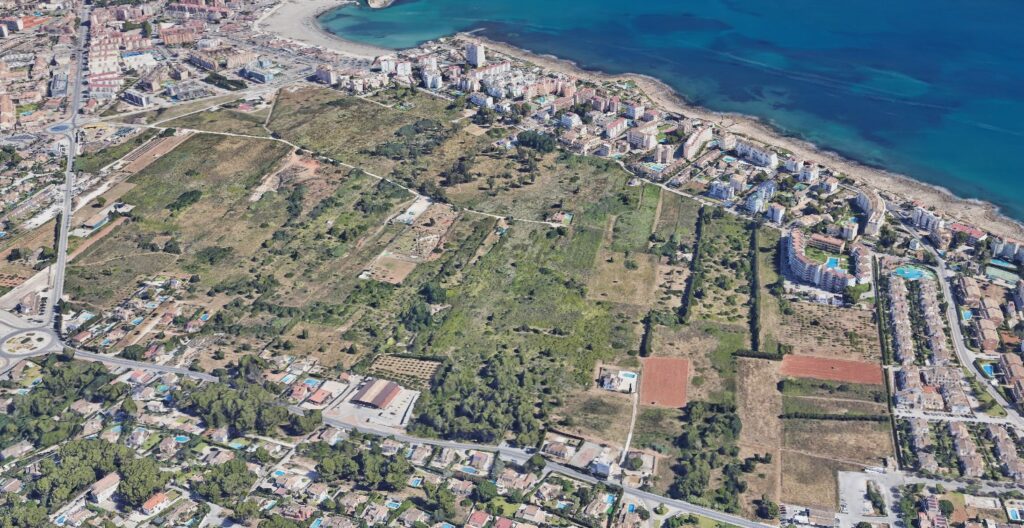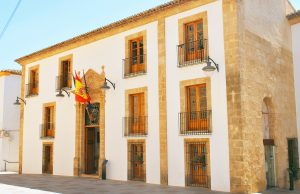Saladar ‘storm park’ making progress but not without controversy
The proposal to build a flood water collection lagoon to alleviate flooding in the Arenal zone is moving towards reality.

In view of the devastating floods that have caused so much damage and heartache in the province of Valencia, it was interesting to note an article in javea.com that reported that work had begun on the construction of a ‘storm park’ in the Saladar zone which aims to provide a solution to the regular flooding of the Arenal during periods of intense rain, conditions that are clearly becoming more likely due to climate change.
The councillor responsible for Town Planning, Pere Sapena (PP), confirmed to the Town Planning Council that the project being carried out in the low-lying area by Xàbia Council in collaboration with the Júcar Hydrographic Confederation (CHJ) is part of one of the solutions proposed by a study carried out in 2022 which looked at various options to reduce the impact of heavy rains in this area.
The study, carried out by a specialized engineering team at the Polytechnic University of Catalonia, concluded that the only option that would make it possible to deal with the flooding would be the creation of a lagoon next to Avinguda dels Tamarits, a reservoir with a high storage capacity, capable of storing most of the precipitation that floods the lower area of the Arenal.
This lagoon that would cover an area of 50,000 square metres, with a maximum depth of 2 metres, so its storage capacity would be around 100.000 cubic metres (four times more than a normal storm tank). This option has now been accepted by the current government team, inspired by the storm park built in Sant Joan, Alicante, although the option of building a storm pond with a smaller capacity had also been considered, but this would only provide a partial solution to the problem.
Councillor Sapena confirmed that the process of creating a storm park that would allow better management of rainfall in the area has started and has the support of the CHJ which would provide the funding for its construction whilst the local council would make the necessary land available. He added, however, that despite the study recommending a lagoon of around 50,000 square metres, the actual capacity is yet to be finalised as it would depend on the amount of land that would be available for the project.
Somewhat controversially, the Town Planning Council was also presented with an additional proposal by Ángel Polomar, president of the Saladar Residents’ Association, for the construction of 1,000 new homes within the storm park area, a suggestion that has been roundly rejected by the PSOE, Compromís and Podem since the area is already classified as flood-prone and incompatible with urban development whilst also having special protection under the Integrated Territorial Action Plan for the Prevention of Flood Risk in the Comunidad Valenciana (PATRICOVA).
José Chulvi, spokesperson for the PSPV-PSOE Xàbia, insisted that this area should be converted into a leisure space with a lagoon that would collect rainwater and that building in a flood zone should be avoided. “We must provide security and not inhabit areas that could endanger the safety of people”.
Carme Català, spokesperson for Compromís, said that her party is in favour of a storm park which would create a green area in the Arenal zone but confirmed that building within this floor-prone area is not viable. “We are in favour of affordable and social housing, but we do not believe that this is the area .. First we need to make the flood-prone park and then we will consider urbanisation”.
Councillor Sapena responded that although massive urban development is not feasible, the possibility of construction some housing on the perimeter of the proposed storm park could be studied, although he added that such an option would “require requesting reclassification permits and other procedures that we don’t know would be accepted”.
However, at this stage, the councillor confirmed that the town council and CHJ still have to sign a commitment agreement to be able to press on and make the storm park a reality.
The Saladar
The Saladar is an area of flat, undeveloped land which is only 1.2 metres above sea level but is protected from the sea by the elevated fossil sand dunes of Muntanyar II. It is prone to flooding during periods of rain as it is fed from the water draining off the hills to the south and the very impermeable subsoil means that it doesn’t drain very easily. During the Roman era, it was used as a sea salt factory, the area being regularly flooded by seawater via a deep channel carved through the tosca stone, the Séquia de la Nòria, which was then left to evaporate, leaving deposits of sea salt. The name “saladar” means “saline ground” or “salt marsh”.
The desire to develop the Saladar area is nothing new. Back in January 2008, a development group calling itself the “Saladar Urban Interest Group” presented a proposal to build over 1,700 houses in the zone, located around an artificial lake which would collect rain water flowing down into the low-lying zone from the surrounding areas of Adsubia, Tosalet, Cansalades and Portixol. During flooding conditions, the lake would spill into the sea at the Arenal beach via a 10m wide open canal which would have been built through what is currently the main car-park at the southern end of the beach area.
In September 2016, an ambitious project promoted by almost 100 landowners in the Saladar area was halted by a change in the law in the Comunidad Valenciana. The proposal presented a project to build a thousand houses and two luxury hotels to create a “City of Sport”, all funded by a British investment fund.





